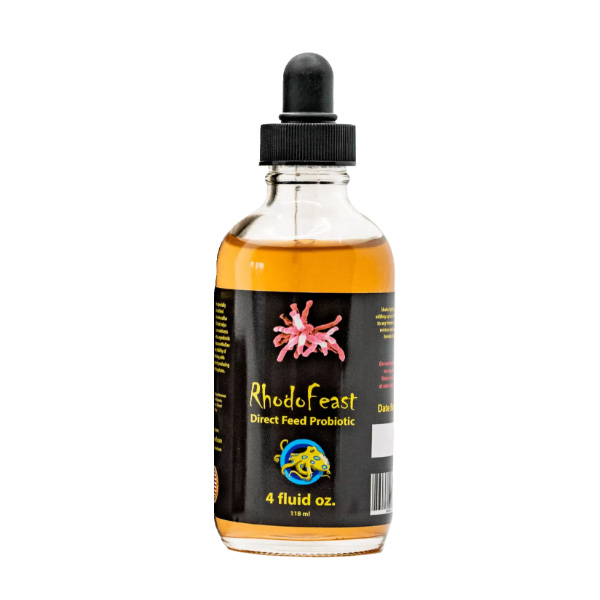Willows Reef RhodoFeast 4oz bottle

RhodoFeast 4oz.
A direct feed Probiotic aquarium supplement you can use with any dry or frozen aquarium food for coral or fish.
This is a live probiotic aquarium supplement. The bacteria in this product are cultured in a specific manner that makes them adapted to colonizing the animal gut. Their express purpose is to provide nutritional and immunological benefits to the fish, corals, and other animals that consume them.
What is it?
- The bacteria in Rhodofeast are Rhodopseudomonas palustris.
- R. palustris is an extremely ancient purple non-sulfur bacterium (PNSB).
- It is flagellated and can swim among the bacterioplankton but can also attach to a substrate and form biofilms. Swimming cells can join films, but not vice versa.
- Like most PNSB, this species is facultatively anaerobic. Especially compared to other PNSB, it proliferates easily in the presence of oxygen but prefers anaerobic conditions.
How does it live and grow?
- Because it can utilize all four major modes of metabolisms, R. palustris is regarded as among the most versatile organisms on Earth. It often uses light as a source of energy and organic matter as a carbon source (photoheterotrophy). It can also function as a complete photoautotroph like algae or as a complete organoheterotroph like an animal.
- Like many of its closest relatives (the rhizobial bacteria), it is a nitrogen fixer (i.e., diazotroph). It can use N2 to form ammonium which is used to build its body.
- It can perform photosynthesis and nitrogen fixation only in anaerobic environments.
Why does it matter to reef aquarists?
- R. palustris occurs widely in nature (including on coral reefs).
- It forms a close relationship with zooxanthellate corals, living in anaerobic areas within the host’s mucus and tissues.
- In this relationship, the bacteria provides a source of biologically available nitrogen to the zooxanthellae. In turn, the bacteria consume dissolved organic matter leached from the coral and zooxanthellae. These interactions serve to nourish the coral and eliminate organic waste products.
- Rhizobial bacteria are so beneficial to corals that corals selectively take them up. Corals alter the content of their mucus to attract and pamper these microbes. Consequently, densities of nitrogen-fixing bacteria are often 400x greater in the mucus than in the surrounding water.
- Coral biologists now credit this symbiosis between zooxanthellate corals and these bacteria as the reason reef ecosystems can be so productive in nutrient-poor waters.
- By using the natural probiotic activity of these bacteria, reef aquarists can enjoy the benefits of a ULN system (e.g., no nuisance algae) while also enjoying excellent coral health/growth.
- Coral farmers have a lot to gain from these microbes. While their purchase price is low, and the investment of time dosing them is minimal, the potential for increased coral yield is substantial.
Are there any other benefits to using it?
- Just as corals feed on their zooxanthellae, they also feed on these bacteria. In addition to its probiotic qualities, R. palustris is an excellent coral food. It is rich in protein (>70%) and provides essential fatty acids (e.g., stearic acid and oleic acid). It contains beneficial carotenoids such as astaxanthin. And, because it lacks a cellulose-based cell wall, it is more digestible than phytoplankton.
- R. palustris synthesizes the antibiotic streptomycin, which has been demonstrated in many cases to inhibit Vibrio (Vibrio is a common and deadly coral pathogen).
- By increasing feed conversion rates, corals (and other animals that consume these microbes) generate less waste–leading to cleaner water.
So, what exactly is in RhodoFeast?
- We list all ingredients in this product. Most importantly, we identify the species of the cultured microbe (Rhodopseudomonas palustris). The medium is comprised of extracts (mainly the ellagitannin Tellimagrandin II) from the invasive aquatic plant Myriophyllum spicatum (wildcrafted under Special Use permits).
- Cultures are grown at a reduced pH and an elevated salinity to condition them for successfully colonizing the host gut.
- These cultures remain viable in their unopened container for many months (or even years) at storage temperatures anywhere above freezing and below 112 degrees Fahrenheit.
How do you use it?
- Add up to one dropper full to each ½ tsp of CoralFeast using the dropper. To avoid contaminating the product, do not allow the dropper to contact the food, your fingers, etc. Replace cap immediately after use.
- Add AminoFeast per product directions.
- Draw slurry into a large syringe and target feed per CoralFeast product directions.
- The microbes used in this product are 100% safe, non-toxic, and nonpathogenic. Therefore, this product cannot be overdosed.
- Store the bottle at room temperature out of direct sunlight.
For more information – Willow’s Reef website






